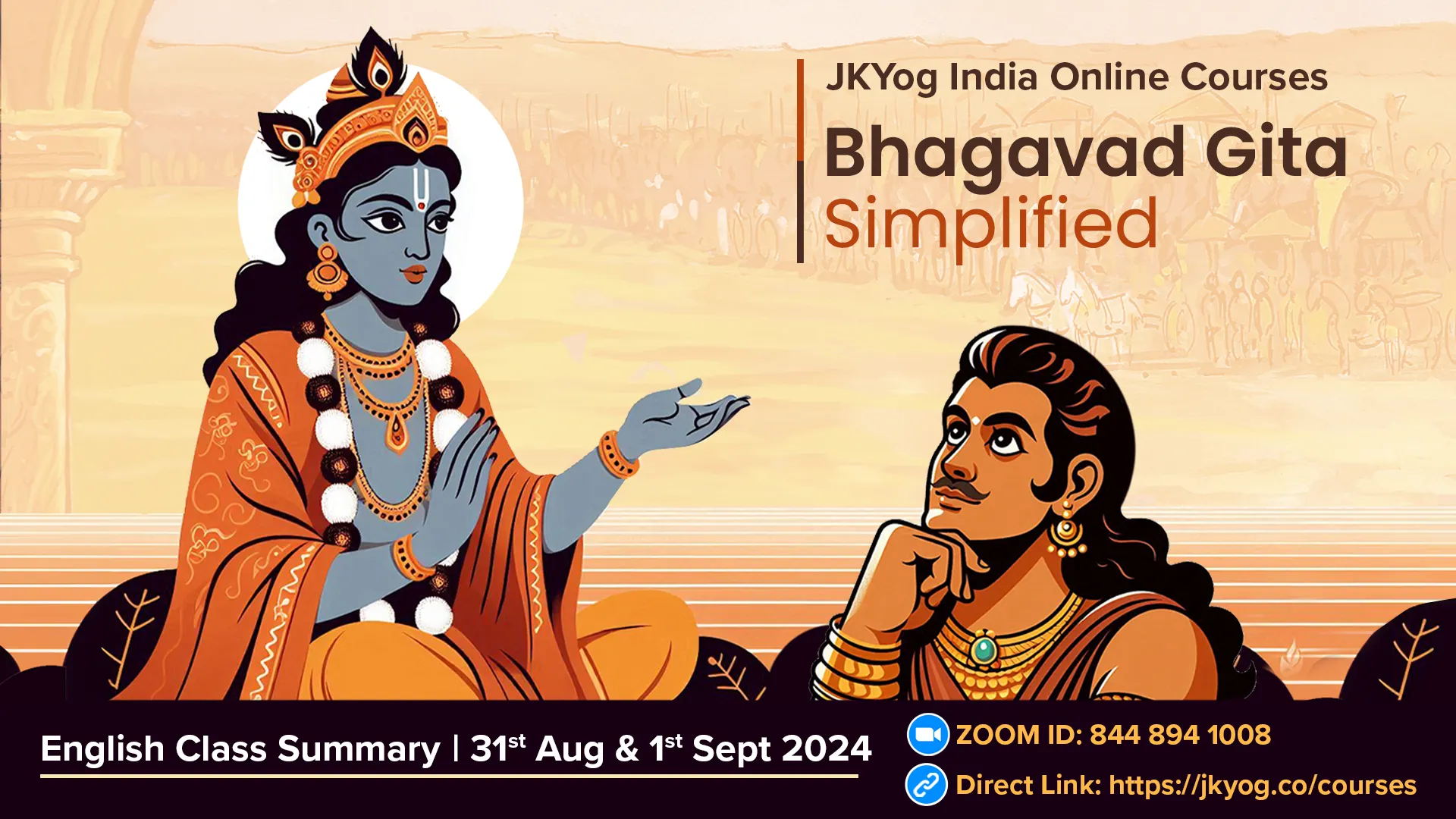In Classes 7 and 8 of the JKYog Online Class on 'Bhagavad Gita Simplified,' we continued to explore profound teachings from the Bhagavad Gita. Class 7 focused on the paths to enlightenment, comparing the Path of Knowledge (Jnana Yog) and the Path of Work (Karma Yog). We examined how each path catered to different temperaments and spiritual inclinations and discussed the balance between action and renunciation. The class highlighted the essence of Yog and the distinction between Yog-aruruksha (beginning spiritual ascent) and Yog-arudha (higher spiritual elevation), emphasising the need for a blend of selfless action and spiritual practice.
Class 8 shifted to the importance of personal responsibility in spiritual growth. We discussed the pivotal role of the mind in our journey towards self-realisation, exploring its potential as both an ally and an adversary. The session covered the nature of the mind, including its four levels—Manas, Buddhi, Chitta, and Ahankar—and strategies for mastering it through Vairagya (detachment) and Abhyas (practice). The emphasis was on taking ownership of our spiritual path, recognising the mind's power, and striving for control through consistent effort and spiritual discipline.
The Path to Enlightenment: Navigating Karma and Yog
In the Bhagavad Gita, Shree Krishna outlines two primary paths to spiritual progress: the Path of Knowledge (Jnana Yog) and the Path of Work (Karma Yog).
Path of Knowledge (Jnana Yog): This path is for those inclined towards deep contemplation and intellectual understanding. It involves knowledge about the self and the divine, leading to self-realisation.
Path of Work (Karma Yog): Ideal for those who prefer action and practical engagement, Karma Yog emphasises performing duties selflessly without attachment to results. Shree Krishna recommends this path for its effectiveness in spiritual progress.
Balancing Action and Renunciation: Karma Yog purifies the mind, preparing it for higher spiritual knowledge. After this purification, one can transition to Karma Sanyas (renunciation), focusing more on meditation and spiritual practices as material activities become less significant.
यं संन्यासमिति प्राहुर्योगं तं विद्धि पाण्डव |
न ह्यसंन्यस्तसङ्कल्पो योगी भवति कश्चन ||
What is known as sanyās is non-different from Yog, for none become yogis without renouncing worldly desires. (Gita 6.2)
In Karma Yog, a person actively engages in performing karma (duties) while maintaining detachment from the fruits of their actions. In Karma Sanyas, a person externally renounces their karma (duties), embracing a life of renunciation. However, internally, both the Karma Yogi and the Karma Sanyasi are deeply engaged in the practice of yog, maintaining an inner attachment to the Divine, transcending external actions and renunciations alike.
The Essence of Yog: Yog represents both the process and the goal of spiritual practice. The goal is "union with God," and the process involves the "path" leading to this union. Yog is metaphorically described as a ladder, with each rung representing a step closer to divine consciousness.
Yog-arurukshu vs. Yog-arudha
- Yog-arurukshu: Those are just beginning their spiritual ascent.
- Yog-arudha: Those who have attained a higher level of spiritual elevation.
Achieving Perfection in Yog:
- Solitude: Seek a clean and quiet place for meditation.
- Mind and Body Control: Maintain a steady posture and focus on the divine.
- Moderation: Balance eating, sleeping, working, and recreation.
- Calm Mind: Achieve tranquillity where the mind rests in divine consciousness.
The ultimate goal of Yog is to experience supreme bliss through divine union, remaining unaffected by external circumstances, just like Prahlad remained steadfast despite severe trials.
Taking Responsibility for Our Spiritual Journey: Mastering the Mind
Embracing Personal Responsibility: Our spiritual progress is solely our responsibility. Despite guidance from saints and countless lifetimes of experience, true God-realisation depends on our willingness to act on these teachings. No one else can walk this path for us; we must take charge of our spiritual evolution.
Elevate Yourself Through the Mind: As highlighted in the Bhagavad Gita (6.5), the mind can be our greatest ally or our worst enemy. The real threats, such as lust, anger, and envy, reside within us, tormenting us more than external sources.
Mind's Power Over Well-being: Negative thoughts can even lead to illness. As Jagadguru Shree Kripaluji Maharaj says, the uncontrolled mind is our enemy. Mastering the mind through spiritual discipline turns it into our greatest friend.
Understanding the Mind:
- Manas: The conscious mind manages sensory input and immediate thoughts.
- Buddhi: The higher mind responsible for analysis and decision-making.
- Chitta: The unconscious mind storing memories and shaping desires.
- Ahankar: The ego creates a limited identity and pride.
Controlling the Mind: Krishna acknowledges the difficulty of controlling the mind but emphasises that practice and detachment can achieve this. By consistently focusing on spiritual goals and practising detachment from distractions, one can master the mind.
Vairagya and Abhyas
- Vairagya (Detachment): Helps clear the mind of worldly distractions.
- Abhyas (Practice): Continuous effort is necessary to train the mind, similar to mastering any skill.
In conclusion, taking responsibility for our spiritual path involves mastering the mind and understanding its nature. By embracing detachment and persistent practice, we can navigate our journey toward God-realization and achieve true enlightenment.
Summary: JKYog India Online Class- Bhagavad Gita Simplified [English]- 31st August and 1st September 2024








